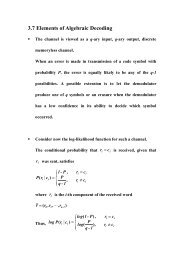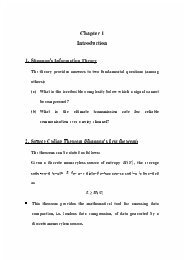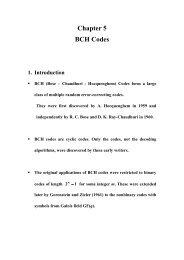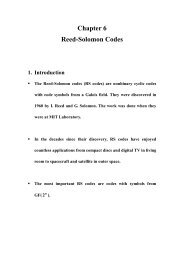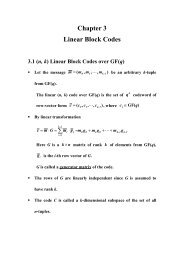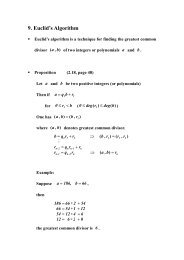Chapter 2
You also want an ePaper? Increase the reach of your titles
YUMPU automatically turns print PDFs into web optimized ePapers that Google loves.
<strong>Chapter</strong> 2<br />
Finite Fields<br />
1. Groups<br />
<br />
A group is an elementary structure, which underlies many other<br />
algebraic structures, such as rings, fields, etc.<br />
<br />
Definition:<br />
Let G be a nonempty set with an algebraic operation o<br />
defined for each pair of its element. Then G is called a group if<br />
and only if for all<br />
a, b,c ∈ G , the operation o satisfies the<br />
following four axioms:<br />
(1) a o b ∈G<br />
(algebraic closure)<br />
(2) There exists an element e ∈G<br />
such that<br />
e o a = a o e = a<br />
( e is identity element)<br />
(3) There exists an element a -1 ∈G<br />
such that<br />
a o a<br />
-1<br />
-1<br />
= a o a = e<br />
(existence of an inverse element)<br />
(4) a o ( b o c)<br />
= ( a o b)<br />
o c (associativity)
If the group G satisfies a o b = b o a ,<br />
then G is called a commutative or Abelian group.<br />
A group is denoted by ( G , o)<br />
<br />
Examples:<br />
The set I 2<br />
= { 0, 1}<br />
with the moduo-2 addition ⊕ is a finite<br />
Abelian group ( I 2<br />
, ⊕)<br />
of order 2.<br />
2. Rings<br />
<br />
Definition:<br />
A non-empty set R with two algebraic operations, written ∗<br />
(called “multiplication”) and + (called “addition”), is called a<br />
ring if and only if these two operations satisfy the following<br />
axioms for all<br />
a, b,c ∈ R:<br />
(1) ( R , + ) is an Abelian group with identity element 0 .<br />
(2) a∗<br />
b∈<br />
R<br />
(closed under multiplication)<br />
(3) a∗ ( b∗c)<br />
= ( a ∗b)<br />
∗c<br />
(associativity of multiplication)<br />
(4) a∗ ( b + c)<br />
= a∗b<br />
+ a∗c<br />
and<br />
( b + c)∗a<br />
= b∗a<br />
+ c ∗a<br />
(distributive laws)<br />
Usually, the ring R is denoted by ( R , + , ∗)
3. Basic Structure of Fields<br />
<br />
Roughly speaking, a field ( )isasetofelementsinwhichone<br />
can perform addition, multiplication, subtraction, and division<br />
without leaving the set. Also, in a field, additions and<br />
multiplications satisfy the commutative, associative, and<br />
distributive laws.<br />
Definition: (field)<br />
Let F be a non-empty set with the two algebraic operations +<br />
and ∗ defined for each pair of elements. Then F is a field if<br />
and only if the following conditions are satisfied:<br />
(1) ( F , + )<br />
is an Abelian group.<br />
The identity element with respect to addition is called the<br />
zero element or the additive identity of F andiddenotedby<br />
0 .<br />
(2) ( F -{<br />
0}<br />
, ∗)<br />
is an Abelian group.<br />
The identity element with respect to multiplication is called<br />
the unit element or the multiplicative identity of F and is<br />
denoted by 1 .
(3) For all a, b,c ∈ F , a∗ ( b + c)<br />
= a∗b<br />
+ a∗c<br />
and<br />
( b + c)∗a<br />
= b∗a<br />
+ c ∗a<br />
i.e. multiplication is distributive over addition.<br />
<br />
Examples:<br />
The set of all rational numbers is the rational field. The set of all<br />
real numbers is the real-number field. The set of all complex<br />
numbers is the complex-number field.<br />
<br />
The complex-number field is actually constructed from the<br />
real-number by requiring the symbol, i = − 1 , as the root of<br />
the irreducible (over the real-number field) polynomial x 2 + 1,<br />
i.e. (− 1)<br />
2 + 1 = 0<br />
Every complex number is of the form<br />
a + bi<br />
where a and b are real numbers.<br />
<br />
The complex-number field contains the real-number field as a<br />
subfield. The complex-number is an extension field of the<br />
real-number field.
Both complex-number field and real-number field have infinite<br />
elements.<br />
4. Binary Arithmetic and Field<br />
Consider the binary set, { 0, 1}<br />
. Define two binary operations,<br />
called addition “ + ” and multiplication “ •” on { 0, 1}<br />
as follows:<br />
0 + 0 = 0<br />
0 + 1 = 1<br />
1 + 0 = 1<br />
1 + 1 = 0<br />
0<br />
0<br />
1<br />
1<br />
• 0 = 0<br />
• 1 = 0<br />
• 0 = 0<br />
• 1 = 1<br />
These two operations are commonly called modulo-2 addition<br />
and multiplication, respectively.<br />
The set { 0, 1}<br />
together with modulo-2 addition and<br />
multiplication is called a binary field, denoted GF(2).
5. Vector Space<br />
<br />
Definition:<br />
Let ( V , + )<br />
be an Abelian group. Let F be commutative field<br />
with the identity elements, 0<br />
and 1 for the operators + and<br />
∗, respectively.<br />
A multiplication operation, denoted by •, between the element in<br />
F and the elements in V , is also defined.<br />
The set V<br />
is called a vector space over the field F if it satisfies<br />
the following conditions:<br />
(1) For any element a∈F<br />
and any element v ∈V<br />
one has<br />
a<br />
• v ∈V<br />
(2) (Distributive law)<br />
For any element<br />
u,v<br />
∈ V , and any elements a, b∈F<br />
one has<br />
a • ( u + v ) = a • u + a<br />
( a + b)<br />
• v = a • v + b<br />
(3) (Associative law)<br />
• v<br />
• v<br />
For any<br />
v ∈V<br />
and any a, b∈ F , one has<br />
( a ∗b)<br />
• v = a • ( b • v)<br />
(4) For any v ∈V<br />
one has 1 • v = v
The elements of V are called vectors. The elements of the field<br />
F are called scalars. The addition on V is called vector addition.<br />
The multiplication, which maps a scalar in F and vector in V<br />
into a vector in V , is called scalar multiplication.<br />
The additive identity (zero) of V is denoted by 0 .<br />
<br />
Definition (subspace)<br />
A vector space V<br />
over a field F may contain a subset S of<br />
V<br />
which is also a vector space over the field. Such a subset is<br />
called a (vector) subspace of V .<br />
6. Vector Space over GF(2)<br />
(<br />
1 2<br />
an<br />
Abinaryn-tuple is an ordered sequence, a ,a , L,<br />
)<br />
with components from GF(2), i.e. a i<br />
= 1 or 0 for 1 ≤ i ≤ n<br />
There are<br />
n<br />
2 distinct binary n-tuples.
Addition operation for any two n-tuples:<br />
( a<br />
1<br />
,a2<br />
, L,an<br />
) + ( b1<br />
,b2<br />
, L,bn<br />
) = ( a1<br />
+ b1<br />
,a2<br />
+ b2<br />
, L,an<br />
+ bn<br />
)<br />
The addition of two binary n-tuples results in a third n-tuple.<br />
<br />
Scalar Multiplication:<br />
Let<br />
(<br />
1 2<br />
an<br />
C ∈GF(2)<br />
, a = a ,a , L,<br />
) is a binary n-tuple.<br />
Then c • ( a1 ,a2<br />
, L ,an<br />
) = ( ca1<br />
,ca2<br />
, L,<br />
can<br />
)<br />
The scalar multiplication also results in a binary n-tuple.<br />
Let Vn<br />
denote the set of all<br />
n<br />
2 binary n-tuples. The set Vn<br />
together with the addition and scalar multiplication is called a<br />
vector space over GF(2).<br />
The elements in<br />
Vn<br />
are called vectors.<br />
<br />
V contains the all-zero n-tuple ( 0,0,L,0)<br />
n<br />
( a ,a , L ,a ) + ( a ,a , L,a<br />
) = ( 0,0, ,0)<br />
1 2 n 1 2 n<br />
L<br />
and
A subset S of Vn<br />
is called a subspace of Vn<br />
if<br />
(1) the all-zero vector is in S .<br />
(2) the sum of two vectors in S is also a vector in S .<br />
<br />
Inner Product:<br />
The inner product of two vectors, a = a ,a , L,<br />
) &<br />
(<br />
1 2<br />
an<br />
b<br />
= ( b ,b , L,<br />
n<br />
) is defined as follows:<br />
1 2<br />
b<br />
a • b = ( a b + a b + L+<br />
a<br />
n<br />
)<br />
1 1 2 2<br />
nb<br />
<br />
Linear Independent:<br />
A set of vectors,<br />
V1 ,V2<br />
, L,<br />
Vk<br />
in Vn<br />
is said to be linearly<br />
independent if c V + c V + L+<br />
c V 0<br />
1 1 2 2<br />
k k<br />
≠<br />
unless all<br />
c L are the zero elements if GF(2).<br />
1<br />
,c2<br />
, , ck<br />
<br />
Dimension of Subspace:<br />
The subspace formed by the<br />
k<br />
2 linearly combinations of k<br />
linearly independent vectors<br />
V1 ,V2<br />
, L,<br />
Vk<br />
in Vn<br />
is called a<br />
k-dimensional subspace of<br />
V<br />
n .<br />
These k vectors are said to span a k-dimensional subspace of<br />
V<br />
n .
Orthogonal:<br />
Two vectors, a and b , are said to be orthogonal if a • b = 0<br />
<br />
Dual space:<br />
Let S be a k-dimensional subspace of V<br />
n . Let<br />
Sd<br />
be the<br />
subspace of vectors in<br />
Vn<br />
such that, for any a in S and any<br />
b in<br />
S , a • b = 0<br />
d<br />
Sd<br />
is called the dual space (or null space) of S . The dimension<br />
of<br />
Sd<br />
is n-k.<br />
7. Binary Irreducible Polynomials<br />
<br />
A polynomial with coefficients from the binary field GF(2) is<br />
called a binary polynomial.<br />
e.g.<br />
2<br />
1 + x and<br />
1 +<br />
3 5<br />
+ x x are binary polynomials.
A binary polynomial p( x)<br />
of degree m is said to be irreducible<br />
if it is not divisible by any binary polynomial of degree less than<br />
m and greater than zero.<br />
e.g.<br />
1 x +<br />
2<br />
+ x ,<br />
1 x +<br />
3<br />
+ x ,<br />
1 +<br />
2 5<br />
+ x x and<br />
1 + x +<br />
5<br />
x<br />
are irreducible polynomials.<br />
For any positive integer m ≥ 1<br />
, there exists at least one<br />
irreducible polynomial of degree m.<br />
A irreducible polynomial p( x)<br />
of degree m is said to be<br />
primitive if the smallest positive integer n for which p( x)<br />
divides x n m<br />
+ 1 is n = 2 - 1<br />
For example,<br />
1 x +<br />
4<br />
+ x is a primitive polynomial. The smallest<br />
positive integer n for which<br />
1 x +<br />
4<br />
+ x divides x n + 1<br />
is<br />
n = 2<br />
4<br />
- 1 = 15<br />
<br />
For any positive integer m, there exists a primitive polynomial of<br />
degree m
Example (Lin / Costello page 29)<br />
m<br />
Primitive Polynomial<br />
3<br />
3<br />
1 + x + x<br />
4<br />
4<br />
1 + x + x<br />
5<br />
2 5<br />
1 + x + x<br />
6<br />
6<br />
1 + x + x<br />
7<br />
3 7<br />
1 + x + x<br />
8<br />
3 4 8<br />
1 + x<br />
2 + x + x + x<br />
9<br />
9<br />
1 + x + x<br />
10<br />
10<br />
1 + x + x<br />
11<br />
2 11<br />
1 + x + x<br />
12<br />
4 6 12<br />
1 + x + x + x + x
8. Finite Fields<br />
<br />
A field with only a finite number of elements is called a finite<br />
field.<br />
<br />
Finite fields are also known as Galois field after their discover.<br />
For any positive integer m ≥ 1<br />
, there exists a Galois field of<br />
m<br />
2 elements, denoted GF(<br />
m<br />
2 ). That is, it is an extension field of<br />
GF(2).<br />
<br />
m<br />
Construction of GF( 2 )<br />
(1) Begin with a primitive (irreducible) polynomial p( x)<br />
of<br />
degree m with coefficients from the binary field GF(2).<br />
(2) Since p( x)<br />
has degree m, itmusthaverootssomewhere.<br />
Let α be the root of p ( x)<br />
,i.e. p ( α)<br />
= 0
(3) Starting from GF(2)= { 0, 1}<br />
and α , we define a<br />
multiplication “ •” to introduce a sequence of powers of α<br />
as follows:<br />
0<br />
0<br />
1<br />
0<br />
1<br />
α<br />
α<br />
α<br />
• 0 = 0<br />
• 1 = 1 • 0 = 0<br />
• 1 = 1<br />
• α = α • 0 = 0<br />
• α = α • 1 = α<br />
2<br />
3<br />
= α<br />
= α<br />
M<br />
• α<br />
• α • α<br />
L<br />
j<br />
= α14243<br />
• α • • α<br />
j times<br />
and we can see that<br />
0<br />
1<br />
α<br />
α<br />
j<br />
•<br />
α<br />
j<br />
•<br />
α<br />
i j<br />
•<br />
= α<br />
= α<br />
j<br />
j<br />
= α<br />
• 0 = 0<br />
j<br />
• 1 = α<br />
i+<br />
j<br />
We now have the following set of elements,<br />
F<br />
2<br />
= { 0, 1,α ,α , L}<br />
which is closed under multiplication “ •”
(4) Since α is a root of p( x)<br />
and p( x)<br />
divides x 2 m −1<br />
+ 1<br />
2 −1<br />
2 −1<br />
α must also be a root of + 1. Hence + 1 = 0 .<br />
x m<br />
x m<br />
2 −1<br />
This implies that = 1 . As a result, F is finite and<br />
x m<br />
consists of following elements,<br />
,<br />
F<br />
= { 0, 1,α<br />
,α<br />
2<br />
, L,α<br />
2<br />
m<br />
−2<br />
}<br />
(5) Let α 0 = 1 . Multiplication is carried out as follows:<br />
m<br />
For 0 ≤ i, j ≤ 2 - 1<br />
α<br />
i<br />
α<br />
j<br />
•<br />
i<br />
= α<br />
+<br />
j<br />
= α<br />
r<br />
Where r is the remainder resulting from dividing<br />
i +<br />
j<br />
by<br />
2 m i 2 -1-i 2 -1<br />
- 1.Since α • α = α = 1<br />
m<br />
m<br />
2 m -1-i<br />
α<br />
is called the multiplicative inverse of<br />
i<br />
α<br />
and vice<br />
versa.<br />
We can also write<br />
α<br />
2<br />
m<br />
-1-i<br />
m<br />
2 -1<br />
= α •<br />
α<br />
-i<br />
= α<br />
-i<br />
Thus, we can use<br />
-i<br />
α<br />
to denote the multiplicative inverse of<br />
i<br />
α<br />
The element “1” is called the multiplicative identity (or the<br />
unit element).<br />
(6) next, we define “division” as follows:<br />
α<br />
i<br />
j i<br />
÷ α = α • α<br />
-j<br />
= α<br />
i- j
(7) we define “addition” on F as follows:<br />
m<br />
For 0 ≤ i ≤ 2 - 2 , we divide<br />
i<br />
X by p(x)<br />
This results in X i = a( x)<br />
p(<br />
x)<br />
+ b(<br />
x)<br />
where b(x)<br />
is the remainder and<br />
b ( x)<br />
= b<br />
L +<br />
2<br />
m-1<br />
0<br />
+ b1<br />
x + b2<br />
x + bm-1<br />
x<br />
Replacing X by α , we have<br />
α<br />
i<br />
= a(<br />
α)<br />
p(<br />
α)<br />
+ b(<br />
α)<br />
= b<br />
0<br />
+ b α + L + b<br />
1<br />
m-1<br />
α<br />
m-1<br />
This says that each nonzero element in F can be expressed<br />
as polynomial of α with degree m-1 or less.<br />
Suppose<br />
i<br />
α = b0<br />
+ b1α<br />
+ L+<br />
b<br />
m-1<br />
α<br />
m-1<br />
j<br />
α = c0<br />
+ c1α<br />
+ L+<br />
c<br />
m-1<br />
α<br />
m-1<br />
We define addition “+” as follows:<br />
i j<br />
m-1<br />
α + α = ( b0<br />
+ c0<br />
) + ( b1<br />
+ c1<br />
) α + L+<br />
( bm-1<br />
+ cm-1<br />
) α =<br />
α<br />
k<br />
i i<br />
(8) Clearly, α + α = 0<br />
Thus,<br />
i<br />
α<br />
is its own additive inverse.<br />
i<br />
- α =<br />
α<br />
i<br />
Subtraction is defined as follows:<br />
i j i j i<br />
α - α = α + (-α<br />
) = α +<br />
α<br />
j<br />
Hence, subtraction is the same as addition.
2 2 −2<br />
(9) we conclude that F = { 0, 1,α ,α , L,α<br />
} together with<br />
the multiplication and addition defined above form a field of<br />
m<br />
2 elements.<br />
m<br />
Such a field is called a Galois field, denoted as GF( 2 )<br />
m<br />
2 m-1<br />
Note: the set { 1, α ,α , L,α<br />
} is called the canonical basis of<br />
m<br />
GF( 2 ) over GF(2)<br />
<br />
m<br />
Representation of the elements in GF( 2 )<br />
m<br />
There are 3 forms to represent the elements in GF( 2 ):<br />
(1) Power form (easier to perform multiplication)<br />
2<br />
{ 0, 1,α ,α , L,α<br />
2<br />
m<br />
−2<br />
(2) Polynomial form (easier to perform addition)<br />
}<br />
b<br />
b<br />
j<br />
α =<br />
0<br />
+<br />
1α<br />
+ L+<br />
b<br />
m-1<br />
α<br />
m-1<br />
(3) Vector form (easier to perform addition)<br />
α<br />
j<br />
=<br />
b<br />
,b<br />
,<br />
,b<br />
(<br />
0 1<br />
L<br />
m-1<br />
)
Example:<br />
4<br />
The Galois field GF( 2 ) generated by<br />
4<br />
p(<br />
x)<br />
= x + x + 1<br />
Power<br />
Representation<br />
Polynomial<br />
representation<br />
4-Tuple<br />
representation<br />
0 0 ( 0 0 0 0 )<br />
1 1 (1 0 0 0 )<br />
α α ( 0 1 0 0 )<br />
2<br />
α<br />
2<br />
α ( 0 0 1 0 )<br />
3<br />
α<br />
3<br />
α ( 0 0 0 1 )<br />
4<br />
α 1 + α (1 1 0 0 )<br />
5<br />
α α +<br />
2<br />
α ( 0 1 1 0 )<br />
6<br />
α<br />
2<br />
α +<br />
3<br />
α ( 0 0 1 1)<br />
7<br />
α 1 + α +<br />
3<br />
α (1 1 0 1 )<br />
8<br />
α 1 +<br />
2<br />
α (1 0 1 0 )<br />
9<br />
α α +<br />
3<br />
α ( 0 1 0 1 )<br />
10<br />
α 1 + α +<br />
2<br />
α (1 1 1 0 )<br />
11<br />
α α +<br />
2<br />
α +<br />
3<br />
α ( 0 1 1 1)<br />
12<br />
α 1 + α +<br />
2<br />
α +<br />
3<br />
α (1 1 1 1 )<br />
13<br />
α 1 +<br />
2<br />
α +<br />
3<br />
α (1 0 1 1)<br />
14<br />
α 1 +<br />
3<br />
α (1 0 0 1 )
Historical Notes<br />
<br />
Galois fields are named in honor of the French mathematician<br />
Evariste Galois (1811 – 1832) who was killed in a duel at the<br />
age of 20. On the eve of his death, he wrote a letter to his friend<br />
in which he gave the results of his theory of algebraic equations,<br />
already presented to the Pairs Academy.<br />
Remarks<br />
1. Galois fields are important in the study of cyclic codes, a<br />
special class of block codes. In particular, they are used for<br />
constructing the well-known random error correcting BCH<br />
and Reed-Solomon Codes.<br />
m<br />
2. GF( 2 ) is an extension field of GF(2).<br />
3. Every Galois field of<br />
m<br />
2 elements is generated by a binary<br />
primitive polynomial of degree m.



